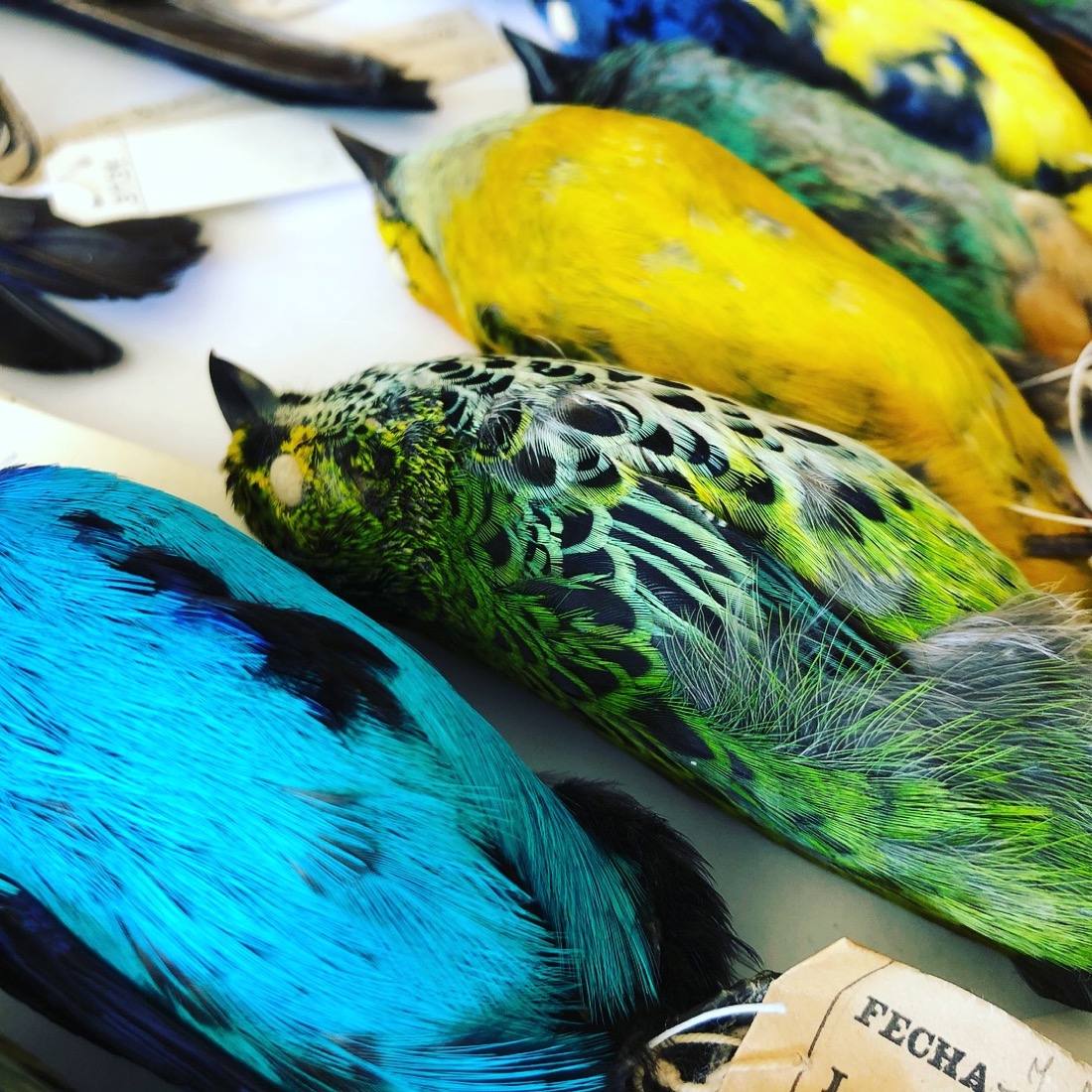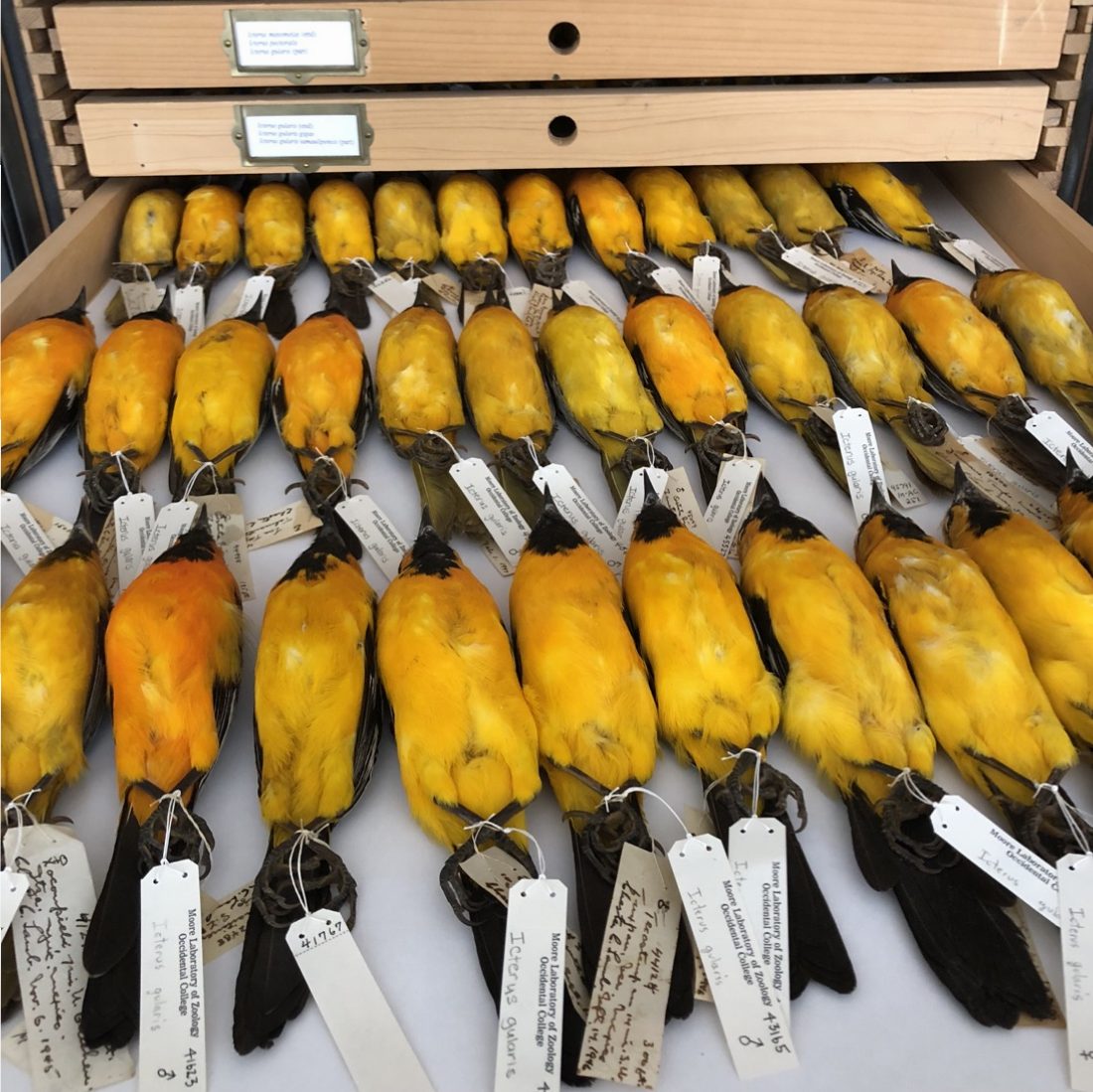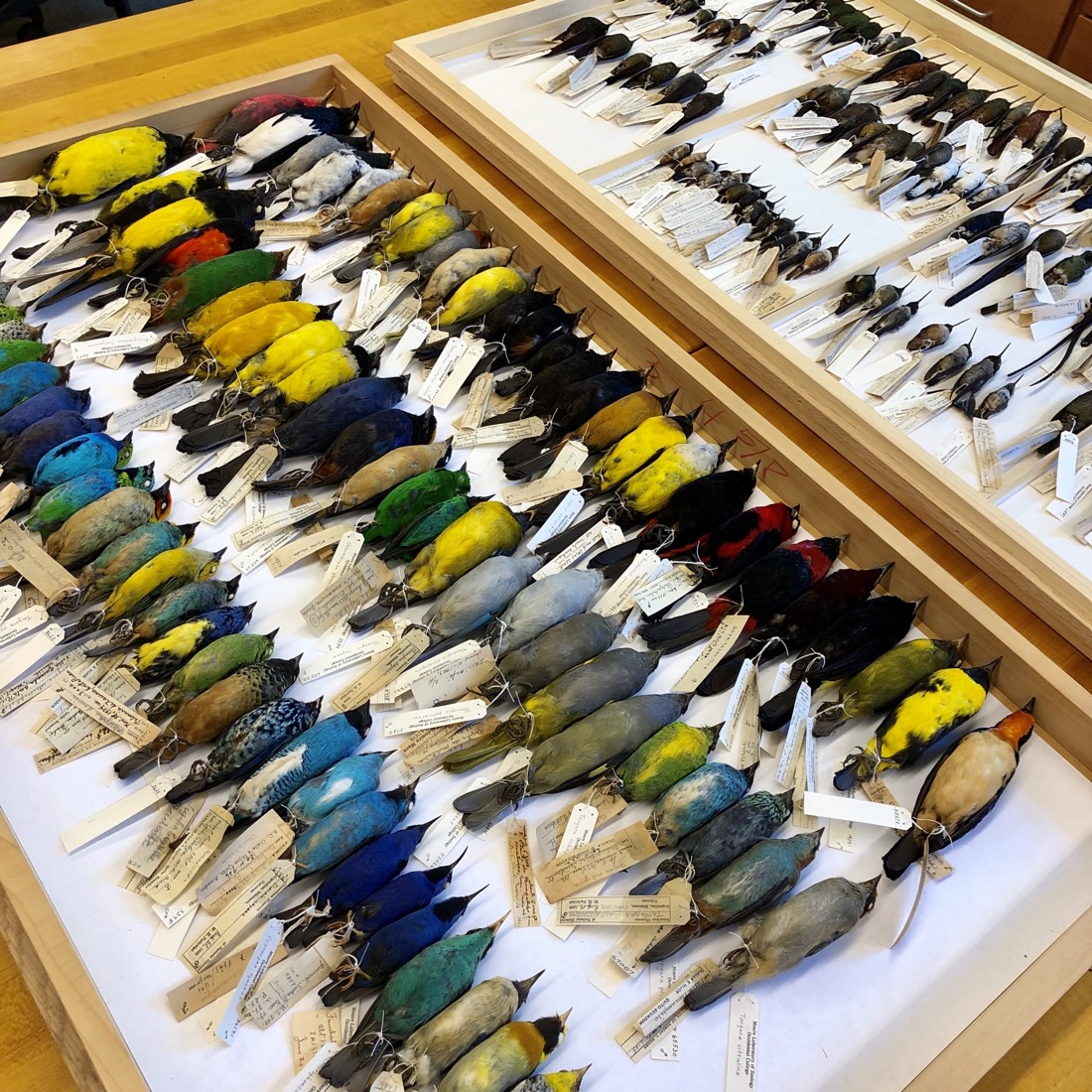A Bird’s-Eye View Of Color
17:28 minutes
 This story is part of our summer Book Club conversation about Jennifer Ackerman’s book ‘The Genius of Birds.’ Want to participate? Sign up for our newsletter or send us your thoughts on the SciFri VoxPop app.
This story is part of our summer Book Club conversation about Jennifer Ackerman’s book ‘The Genius of Birds.’ Want to participate? Sign up for our newsletter or send us your thoughts on the SciFri VoxPop app.
Birds don’t just see the world from higher up than the rest of us; they also see a whole range of light that we can’t. Researchers have known for decades that birds have a fourth color cone in their eyes that lets them see ultraviolet wavelengths. But as birds use the colors of their feathers to hide from predators or attract mates, how does their extra-dimensional vision influence their plumage? It turns out the feathers of many birds are secretly signaling in the UV spectrum.
So what does a bird look like… to another bird? Ira talks to bird researchers Cassie Stoddard and Allison Shultz about evolution, communication, and feathers.
Plus, learn more about how researchers at the Moore Lab of Zoology at Occidental College in Los Angeles are developing new methods to visualize the unseen spectrum of bird plumage.



Mary Caswell “Cassie” Stoddard is an assistant professor of Ecology and Evolutionary Biology at Princeton University in Princeton, New Jersey.
Allison Shultz is an assistant curator of Ornithology at the Natural History Museum of Los Angeles County. She’s also a Visiting Scholar at the University of Southern California in Los Angeles, California.
IRA FLATOW: This is Science Friday. I’m Ira Flatow. Our book club is mid-flight this summer, reading Jennifer Ackerman’s The Genius of Birds. If you’ve been following along, you know we’ve been learning about some of the many brilliant tricks birds have, from impressive tool-making talents of crows to elaborate feats of artistry in the Bauer birds of New Guinea.
We asked you on our Science Friday VoxPop app whether birds like Bauer birds can be artistic. Peter Barber in New Zealand thought yes, if we just think what our art is.
PETER BARBER: Birds can be artistic. I’m a musician. It seems to me that all forms of art, be it music, or dance, or sculpture, or painting, they seem to me to be forms of courtship display. So there you go. I think birds are doing the same thing.
IRA FLATOW: Another test of bird artistry, how about themselves? Birds are some of the most colorful creatures on the planet from the dazzling, iridescent displays of hummingbirds to the many hued birds of paradise. But it turns out that birds may even be more colorful than we thought since their vision sees well into the ultraviolet range.
And researchers studying bird feathers are finding there’s more than meets the eye in bird plumage. Patterns only visible in the UV range and colors that look the same to us, but from a different bird’s eye view seem quite different. That’s all quite interesting stuff, and that’s what we’re going to be talking about with my guest, Dr. Mary Caswell Stoddard, assistant professor of Ecology, Evolutionary Biology at Princeton University. Welcome, Dr. Stoddard.
MARY STODDARD: Thank you.
IRA FLATOW: And Dr. Allison Shultz, assistant curator of Ornithology at the Natural History Museum of Los Angeles in LA. Welcome, Dr. Shultz.
ALLISON SHULTZ: Thank you. It’s a pleasure to be here.
IRA FLATOW: Nice to have you. Let me ask you first– what’s so special about how birds see the world?
ALLISON SHULTZ: Well, I can go ahead and answer that. Well, as you just mentioned, birds see more than we can. So as humans, we have three types of cones in our eyes that can detect color– kind of red, green, and blue. And if we’re talking what part of the electromagnetic spectrum we can see, we see from about 400 nanometers to 700 nanometers.
But birds actually have a fourth type of cone in their eye, and this cone resides in the ultraviolet part of the spectrum. So from a bird’s eye view, they can actually see down to 300 nanometers and all the way up to 700. And that fourth cone type actually gives them kind of three-dimensional vision, whereas we have somewhat we could think of as two-dimensional color vision.
IRA FLATOW: Does every bird have this?
MARY STODDARD: I would just chime in there. Yes, we think that this is a widespread feature of bird vision. We call this tetrachromatic. Birds have these four types of color cones or photo receptors in their eyes. And a lot of times, you might think that that just gives birds the ability to see all of the colors we humans can see, plus some ultraviolet tacked on.
But actually, we think that birds can perceive an extra dimension of color. They have very interesting combination colors like ultraviolet plus green and ultraviolet plus red that we can’t even imagine. These are [INAUDIBLE] colors that we believe birds can perceive.
IRA FLATOW: That is just crazy. They’ve got a fourth– another dimension that you can mix colors with, right?
MARY STODDARD: Exactly.
IRA FLATOW: So they can create a crazy purple we can’t see or some other thing. We need a new word for it because we don’t have that color.
ALLISON SHULTZ: Yep. That’s right, and we–
IRA FLATOW: No, go ahead.
ALLISON SHULTZ: –do think that these colors exist in the environment. As you mentioned, they are producing some of these special colors with their feathers, and we know that flowers have some of these colors in them, too. And so these colors exist for these birds in their natural world.
IRA FLATOW: Huh, OK. Here’s a question. I’ve thought about this. When did birds evolve this ability? I’m asking you this, because we talk about dinosaurs as being birds. Did dinosaurs have this ability also? Cassie, what do you think?
MARY STODDARD: Well, dinosaurs very likely had tetrachromatic vision, very similar to modern birds. This type of visual system exists in many fish and lizards. And it is ancient. It evolved early in vertebrates. And we know now that many dinosaurs had feathers, and probably very colorful feathers, too. So it’s not just that they had tetrachromatic vision probably, but they must have looked more stunning to each other than we can even fathom.
IRA FLATOW: So do you think our mammal human ancestors had this ability, but we lost it somewhere along the line?
MARY STODDARD: That’s exactly right. We think that this ancient tetrachromatic visual system changed through our own evolutionary history. A mammal lost two of the four color cone types, and it was one group of primates, the old world primates, that re-evolved a third color cone that gives modern humans the trichromatic or three color code system that we enjoy today.
IRA FLATOW: Wow. So if birds see the world differently, does this mean they look different to each other than they look to us? It would seem that they do.
MARY STODDARD: Allison, do you want to take that one?
ALLISON SHULTZ: Sure, yeah. So, absolutely. So birds definitely look different to each other than how we perceive them, and that’s actually shaped how we’re studying how bird colors evolved. In the past, there was really a bias to thinking about how bird colors evolved from a human visual perspective. We categorize things as what we think of as colorful, what we think of as drab.
But there’s a lot that we’re simply missing. So for example, I study a group of birds called tanagers, and if you were to look in field guides, you would think that about 50% of tanagers, or about half of teenagers, the males and the females are the same color. However, when I measured all these tanagers and kind of applied an avian visual model– so we model how we think birds are seeing each other– actually, we think about 93%, or almost all of them, actually have differences between the males and the females that we simply can’t perceive with our eyes.
IRA FLATOW: That’s quite interesting. Our number’s 844-724-8255, 844-724-8255. You can also tweet us at @scifri. Now color is often a really important part of how birds mate, right? Is this why they have this enhanced color vision, Cassie?
MARY STODDARD: Well, color is definitely seductive, and we think that many colorful birds have evolved these vibrant feathers to attract mates. We do some work in my lab on the broad-tailed hummingbird in the Colorado Rockies, and they have spectacular, iridescent feathers that they use in their own courtship displays. And of course, some of the most charismatic birds that come to mind are using color.
But there are other reasons to have plumage and feathers that have particular colors beyond mate choice. So they can be used for social interactions if birds are communicating their dominance in a group, for example, or it can be used for individual recognition.
Of course plumage can also be important for camouflage. There’s a bird called a ptarmigan that can change color with the season, actually. So in the winter, its plumage matches the snow. And in summer, its feathers have molted. It gets a new plumage in, and that matches the dirt in the rocky substrate. So there are many different explanations for why birds are colorful or why they’re drab.
IRA FLATOW: Do we know why– is a rule that male birds are more colorful than females? Is it just because of that mating, attraction?
ALLISON SHULTZ: Generally, we do think that. What we’ve seen in almost all cases, males are more colorful females, and it probably is due to mate choice, either to attract females, or to have males kind of communicate amongst each other to kind of avoid conflicts of territoriality, or to gain access to different resources. So yes, for the most part, males are more colorful.
Now interestingly, there are some species where the roles are reversed, where females are actually the ones who are choosing or the males are choosing the females. The females might have multiple mates, and in those cases, actually, the females are more colorful. So we kind of see both things. But for the most part, it is the males who are more colorful.
IRA FLATOW: Hm. Cassie, you’re looking at hummingbird mating displays as one example of birds using color in a really interesting way. What are male hummingbirds doing to impress the females?
MARY STODDARD: Well, the males that we study, the male broad-tailed hummingbirds, they perform these absolutely dazzling courtship dives to females. These males fly more than 50 feet sort of straight up in the air, and then they do a death defying U-shaped dive over the female’s head. And you really have to see it to believe it. And the first time I saw it, I almost fell over.
But at the bottom of the dive, the males are going extremely fast, and they snap their tail feathers together to make a very loud buzz. And they show off their magenta iridescent throat feathers. And in my lab, we’ve been analyzing these dives, and we’ve discovered that all of the action happens in about 300 milliseconds right at the base of the dive. And if you blink your eyes, that’s 300 milliseconds. So these males have evolved to deliver a sensory explosion of sound, and color, and speed to females right at the correct moment.
IRA FLATOW: Wow, that is quite– I’ve been trying to attract hummingbirds for years. I’ve been successful, pretty successful lately, but I have not seen that dive maneuver. I will have to look out for it. But one thing I do notice when I look at the hummingbirds is that the colors seem to oscillate, is the way I could put it. The colors seem to change iridescence a little bit as I’m looking at the feathers. What is going on there?
MARY STODDARD: Well, iridescence is a very special type of color. Birds can make their colors in many different ways. They can have pigments that they are producing inside their bodies or that they’re obtaining from the diet. Or they can have colors that are called structural colors. And in these colors, it’s the interaction of light with the feather structure itself that gives a bird feather a particular appearance. So a blue jay blue is one type of structural color. And if you grind up a blue jay feather, you’d just be left with black dust because you’ve disrupted the feather structure at that point.
Iridescence is a structural color as well, and that’s where the appearance of the color changes with the angle formed by the light, and the feather, and the viewer’s eye. And so that’s what you’re observing with hummingbirds, is sort of special angle dependent kind of color. And if you were to dissect a hummingbird feather and look under the microscope, you would see little layers of blobs called melanosomes packed with a black melanin pigment arranged in very precise layers. And it’s how the light is interacting with these layers that gives hummingbirds their iridescent appearance.
IRA FLATOW: I’m Ira Flatow. This is Science Friday from WNYC Studios, talking with Allison Shultz and Cassie Stoddard about bird color. We have some listeners who’d like to join us, and we’re always happy to have them. Let’s go to Tony in Minnesota. Hi, welcome to Science Friday.
TONY: Hi. Thanks for having me, and really interesting show. Yeah, I had a question– the two speakers that earlier mentioned that this fourth kind of cone in these birds’ eyes allowed them to see another dimension of color. And I was wondering if they could maybe unpack that a little more. Like, is that another spatial dimension, or is this just kind of like a new concept altogether? Thanks.
IRA FLATOW: Yeah. Good question.
ALLISON SHULTZ: Well, when we say another dimension of color, it’s kind of like– so if we think about where– like, a human color space, you can think about how hues exist in a two-dimensional space where you have kind of how the proportions of red, green, and blue will make up a hue that we see.
However, when you have add a fourth cone there, basically, you’re adding– you now have to turn that two-dimensional space into a three-dimensional space. And so it’s hard for us to imagine because we have our own sensory systems.
But when I talk to people and try– everybody always asks me, hey, Allison, could you make some sort of goggles or something that could make us see like birds? And unfortunately, we can’t because our brains are just not wired that way.
But one thing I like to do is kind of take a picture and turn off one of the colors that we see, so for example, red. So if you turned off all red in the picture, it would be very different from what we see. And so you can kind of imagine adding a whole other dimension in that way. That’s kind of the closest that I can come up with.
IRA FLATOW: And in fact, we’ve had a question, a Twitter question came in that I was wondering about, is, is there a set of goggles, or glasses, or something that we could use to see what the birds see? Anybody make that?
MARY STODDARD: Well, as Allison mentioned, that is a pipe dream. But it’s really more complicated than that because we know that it’s about how these four types of color cones interact with one another. And so we don’t have the neurons to compute what these colors might actually look like, even if we could have goggles or a particular camera that can detect the UV.
Now even if we can’t have goggles that really give us a bird’s eye view of the world, we do have technology that allows us to capture UV reflected light in the environment and in feathers. And that’s something that we’re working on in the lab, and I know Allison is doing work in this realm as well.
And that’s been a really exciting move forward for our field, that now we can use ultraviolet sensitive cameras to go out and take pictures and measure where ultraviolet light resides. And we are finding in lots of bird feathers that there is hidden ultraviolet color embedded in plumage patches that we can use this technology to highlight.
IRA FLATOW: I just got about 30 seconds to go. One last question, Cassie. You also looked at birds’ eggs. Is color important also in the bird eggs?
MARY STODDARD: Absolutely. Birds lay spectacularly colorful eggs. My favorite is the emerald green egg laid by the emu, which is a large flightless bird. And we know that egg color can be used for camouflaged or thermo regulation, but it can also be really important for deception.
So we work on a bird called the common cuckoo that sneaks its eggs into the nests of other species, and it leaves all parental care to these host birds. And they’re really ultimate freeloaders. And these cuckoos have evolved eggs that can precisely mimic the color and pattern of the host eggs so the other birds won’t notice. So they’re really the forgers of the bird world. And if you want to learn something really interesting about color and deception, look up cuckoo eggs because there’s so much–
IRA FLATOW: I will do that.
MARY STODDARD: –cool stuff there.
IRA FLATOW: Cassie Stoddard, assistant professor of Ecology, Evolutionary Biology at Princeton, and Allison Shultz, assistant curator of Ornithology at the Natural History Museum of LA, thank you both for joining us today. Have a great weekend.
MARY STODDARD: Thank you very much for having us.
IRA FLATOW: You can learn more about the bird vision and researchers working to digitize all these crazy plumage colors in a new article on our website, ScienceFriday.com/color. Plus crazy about crows, or ravens, or other members of the corvid family? Learn more about crow funerals, grudges, and other feats of intellect from [? Kaylee ?] [? Swift ?] in a Reddit AMA, Ask Me Anything. That’s next Monday at noon Eastern. All that and more on our website– it’s ScienceFriday.com/bookclub.
We’d like to thank all the folks here at Texas Public Radio who helped us get our program on the air today– Wayne Coble, Ruben Garcia, the great folks at Texas Public Radio in San Antonio, who made us so welcome here today. And for you Texas folks in Texas, we hope to see you tomorrow night at the Tobin Center here in San Antonio. Still a few tickets left– ScienceFriday.com/SanAntonio. Until then, in San Antonio, I’m Ira Flatow.
Copyright © 2019 Science Friday Initiative. All rights reserved. Science Friday transcripts are produced on a tight deadline by 3Play Media. Fidelity to the original aired/published audio or video file might vary, and text might be updated or amended in the future. For the authoritative record of Science Friday’s programming, please visit the original aired/published recording. For terms of use and more information, visit our policies pages at http://www.sciencefriday.com/about/policies/
Christie Taylor was a producer for Science Friday. Her days involved diligent research, too many phone calls for an introvert, and asking scientists if they have any audio of that narwhal heartbeat.